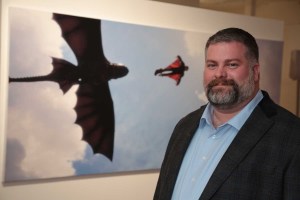
For DeBlois, the Dragon journey began in pre-production of the first film, released in 2010. “Both [co-director] Chris Sanders and I were brought on a little over 15 months out from its fixed release date,” DeBlois said of the first Dragon project. “They were in trouble because they had spent two years in a faithful adaptation of the book [by Cressida Cowell]. The story material itself was feeling a little thin – a little young. We departed from the narrative with a fantasy/action-adventure feel to it.”
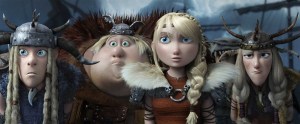
How to Train Your Dragon was a surprise hit for DreamWorks, earning almost $500 million, which is especially surprising for an original title. “It was celebrated as a hit,” DeBlois explained. “It was a different tone for the studio and, for a while, the execs were unsure about that [as they had been] successful with pop culture-driven humor. It wasn’t a big laugher. It was much more earnest in its execution and classical in its construction. As a tonal option for the studio, they were comfortable going that way.”
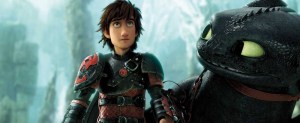 Though the first Dragon film lost in all early 2011 key awards shows to Toy Story 3, DeBlois noted that TS3 “was a fine competitor to lose to.” Regardless, back in February of 2010, when DeBlois was in postproduction on Dragon at Skywalker Ranch, Katzenberg asked him to come up with ideas for a sequel. “I pitched back the concept that it should be the middle act of a trilogy,” DeBlois revealed of How to Train Your Dragon 2. “This would be the middle of the story – Hiccup’s overall coming of age, a finite structure with a third installment. Key off certain elements from the first film and set up the third, but be satisfying in and of itself.”
Though the first Dragon film lost in all early 2011 key awards shows to Toy Story 3, DeBlois noted that TS3 “was a fine competitor to lose to.” Regardless, back in February of 2010, when DeBlois was in postproduction on Dragon at Skywalker Ranch, Katzenberg asked him to come up with ideas for a sequel. “I pitched back the concept that it should be the middle act of a trilogy,” DeBlois revealed of How to Train Your Dragon 2. “This would be the middle of the story – Hiccup’s overall coming of age, a finite structure with a third installment. Key off certain elements from the first film and set up the third, but be satisfying in and of itself.”
Going forward into the sequel, DeBlois pulled together the key creative team from the first Dragon, but introduced new players as well. “Lots of new faces to complement the old hats,” he stated. “We took advantage of many years of development of software tools. Apollo allowed scale and complexity and thousands of characters with subtle real-time results for the animators. It cuts out the cumbersome middle between the idea and execution. Everybody had to get used to the new tools. We had a full three years of production from start to finish, and I think it shows on the screen. There’s so much more polish.”
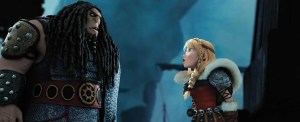 Surely, in any sequel, especially one beloved by children, anticipation runs high, putting intense expectations on DeBlois and his team. “We were very conscious of not wanting to disappoint or fall short of the mark of the first film,” he said. “All along, I kept asking the crew if it was living up to the huge pressure of the first film. For me, there’s a lot more personal story in this one. The rite of passage that Hiccup goes through in becoming an adult was something I went through at that age. It took on so much more importance for me. Having that element in the storyline and knowing that it was a bit daring to put it in there, it would be challenging for the audience.”
Surely, in any sequel, especially one beloved by children, anticipation runs high, putting intense expectations on DeBlois and his team. “We were very conscious of not wanting to disappoint or fall short of the mark of the first film,” he said. “All along, I kept asking the crew if it was living up to the huge pressure of the first film. For me, there’s a lot more personal story in this one. The rite of passage that Hiccup goes through in becoming an adult was something I went through at that age. It took on so much more importance for me. Having that element in the storyline and knowing that it was a bit daring to put it in there, it would be challenging for the audience.”
Though the reported budget on the first Dragon was $165 million, DeBlois had $145 million for the sequel, necessitating careful preparation prior to the production of any actual animation. “There’s an eagerness to start developing the movie visually and doing early tests and amassing a crew before the story has been figured out,” he confessed. “We had six months in the writing and outlining process, so that when people came onto the movie, they had a sense that this was the movie we were making. We made the movie in a smarter way. We spent money wiser.”
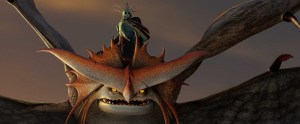 To adequately prepare for Dragons 2, DeBlois engaged his crew in ample storyboarding moving forward into creating full story reels. “We are all trained in the same methods, putting up a working version of the movie with our storyboard drawings,” he described. “We have music, dialogue and effects with still images describing each and every shot of the movie. It becomes a blueprint, a working model. We edit our movie first before any of the real money has been spent. We replace the storyboards with shots.”
To adequately prepare for Dragons 2, DeBlois engaged his crew in ample storyboarding moving forward into creating full story reels. “We are all trained in the same methods, putting up a working version of the movie with our storyboard drawings,” he described. “We have music, dialogue and effects with still images describing each and every shot of the movie. It becomes a blueprint, a working model. We edit our movie first before any of the real money has been spent. We replace the storyboards with shots.”
With DeBlois and Dragons 2 having each won an Annie, both he and DreamWorks are already headlong into creating the final film in the trilogy. “I’ve pitched several outlines and am halfway through the first draft of the script,” he conveyed. “We will be out in summer of 2018. Dragons will be a decade of my life. Animation is wonderful because you can control everything, but it’s really hard to be prolific. I would love at the end of the day, being such a Star Wars kid, to feel a sense of ownership of a trilogy that has had an impact on kids.”





